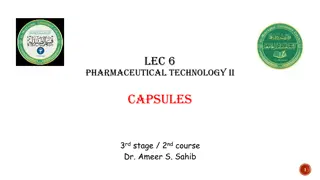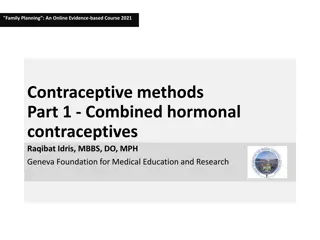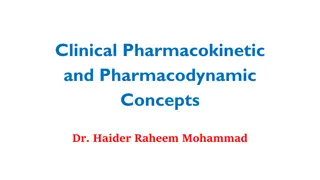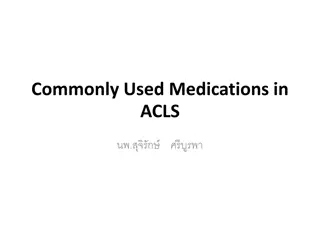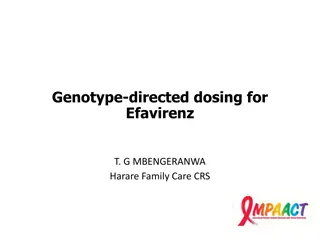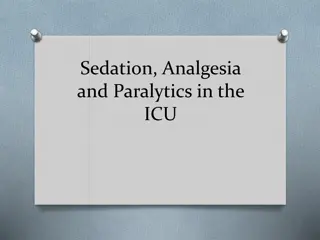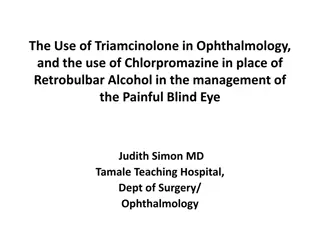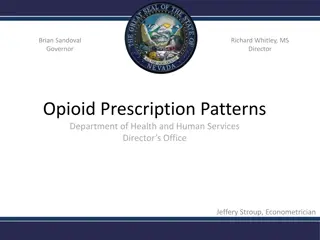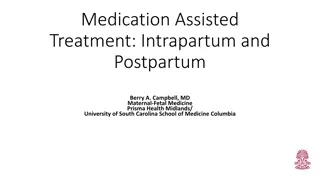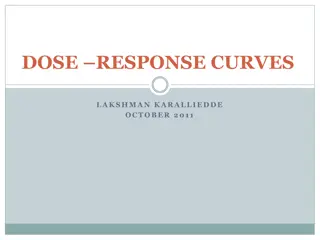Emergency Drugs and Their Mechanisms of Action
Learn about essential emergency drugs such as Adrenaline, Adenosine, Atropine, Furosemide, Calcium Gluconate, and Lidocaine. Understand their mechanisms of action, dosages, indications, and onset times to effectively manage cardiac arrest, anaphylaxis, arrhythmias, and other critical conditions.
3 views • 17 slides
Understanding Aminoglycoside Antibiotics and Dosing Strategies
Aminoglycoside antibiotics are potent but require precise dosing due to variability among patients. Suggested dosing adjustments based on serum concentrations can ensure therapeutic levels without toxicity. Various methods, like linear pharmacokinetics, individualized dosing, and computerized progra
16 views • 71 slides
Advances in Particle Therapy: Slow Extraction and Dose Delivery at Medical Facilities
Medical facilities, like Heidelberg University Hospital, utilize advanced techniques such as slow extraction and raster scanning for precise dose delivery in particle therapy. The demands on these facilities include safe and precise beam parameters, uninterrupted therapy sessions, and fast irradiati
2 views • 23 slides
AHD Toolkit App for Advanced HIV Disease Management
Developed with support from Unitaid, CHAI, and the Infectious Diseases Institute Uganda, the AHD Toolkit App is a mobile application linked to the Global Advanced HIV Disease Toolkit. It aims to provide versatile support to frontline healthcare workers managing AHD clients. The app offers key facts
1 views • 5 slides
Understanding the Advantages of Gelatin Capsules in Pharmaceutical Technology
Gelatin capsules are a popular solid dosage form for medicinal agents due to their convenience, stability, and flexibility in dosages. This article explores the composition of gelatin capsules, their advantages, and the effects of moisture on their quality.
1 views • 41 slides
Pediatric Dosage Calculations: Safe Medication Administration Guidelines
Learn how to calculate safe pediatric dosages for common medications such as Acetaminophen, Augmentin, Amoxicillin, and Ferrous Sulfate. Follow step-by-step instructions to determine the correct amount of medication to administer based on a child's weight and prescribed dosage. Ensure accuracy in do
1 views • 5 slides
Medical Calculations Review for Nurses
This set of image-guided practice questions covers various IV calculations, including IV bolus administration, hourly infusion rates, drip rates, and infusion duration. Test your competency in calculating medication dosages and infusion rates to enhance your proficiency as a nurse.
0 views • 9 slides
Understanding Combined Hormonal Contraceptives for Family Planning
Explore the world of combined hormonal contraceptives in this informative course. Learn about different methods, effectiveness, benefits, side effects, and eligibility criteria. Discover how to enhance the effectiveness of your chosen method and compare it with other family planning options. Dive in
0 views • 77 slides
Understanding Clinical Pharmacokinetic and Pharmacodynamic Concepts
Clinical pharmacokinetics involves applying pharmacokinetic principles to personalize medication dosages for optimal therapeutic effects while minimizing adverse reactions. It covers drug absorption, distribution, metabolism, and excretion. Pharmacodynamics focuses on the relationship between drug c
0 views • 55 slides
Medication Dosage Calculations Practice
Practice calculating medication dosages for Tegretol, Theo-Dur, Atropine, and Heparin based on prescription orders and label information. Determine the correct amount of medication in milliliters or number of tablets to administer per dose. Enhance your pharmacy or healthcare skills with these dosag
0 views • 5 slides
Commonly Used Medications in ACLS: Adenosine, Amiodarone, Atropine, Dopamine, Epinephrine
Adenosine is used for SVT, Amiodarone for VT/VF, Atropine for bradycardia, Dopamine for shock, and Epinephrine for cardiac arrest. Each medication has specific dosages and side effects. These drugs play crucial roles in advanced cardiac life support scenarios.
8 views • 16 slides
The Importance of Algebra in Everyday Life
Algebra plays a crucial role in various professions and daily activities such as shopping, budgeting, and problem-solving. It is essential for jobs in fields like farming, construction, animation, computer science, and more. Utilizing algebraic formulas can help in practical scenarios, like determin
1 views • 17 slides
Genotype-Directed Dosing for Efavirenz in Children Study
The study focuses on genotype-directed dosing of Efavirenz in children with HIV, aiming to optimize treatment options and dosages based on genetic factors. It explores the challenges in treating children with HIV, especially in resource-limited settings, and discusses the impact of genetic variation
0 views • 21 slides
Understanding Antibiotic Resistance in Recycled Wastewater
Explore the potential connection between recycled municipal wastewater and antibiotic resistance. Antibiotic-resistant bacteria pose a serious threat, fueled by factors like horizontal gene transfer and high antibiotic dosages in clinical settings. Environmental antibiotic resistance, linked to agri
4 views • 46 slides
Sedation, Analgesia, and Paralytics in the ICU: A Comprehensive Guide
This comprehensive guide delves into the use of sedatives, analgesics, and paralytics in the intensive care unit (ICU). It covers various medications like Etomidate, Propofol, Ketamine, Benzodiazepenes, and Dexmedetomidine, detailing their indications, dosages, and effects. Understanding the role of
0 views • 21 slides
Triamcinolone in Ophthalmology and Chlorpromazine for Painful Blind Eye
Triamcinolone is a potent synthetic corticosteroid used orally, by injection, inhalation, or topically for various eye conditions. Triamcinolone Acetonide, a more potent form, is commonly used in ophthalmology to manage inflammation. Chlorpromazine is suggested as an alternative to Retrobulbar Alcoh
0 views • 35 slides
Analysis of Medicaid Patient Demographics and Opioid Prescriptions
Data gathered from the Medicaid data warehouse from October 2014 to September 2015 reveals demographics of Medicaid patients receiving opioids in terms of age groups, race, gender, and region. The information includes percentages of patients in each category, such as age ranges, racial backgrounds,
0 views • 24 slides
Genomic Imputation Pipeline Overview
This document outlines a genomic imputation pipeline for multiple GWAS studies using reference panels such as 1000 Genomes Phase I data. It covers steps like data matching, phasing, and imputation using tools like Beagle and Minimac. The expected output includes imputed dosages and quality measures.
0 views • 6 slides
Medication-Assisted Treatment in Intrapartum and Postpartum Care
Explore guidelines for medication-assisted treatment during intrapartum and postpartum periods, emphasizing pain management strategies for opioid-dependent patients. Tips include adjusting dosages, adding NSAIDs, and considering opioid agonists with high mu receptor affinity. Careful monitoring and
0 views • 12 slides
Understanding Fluoride Supplements for Dental Health
Fluoride supplements are recommended for individuals living in non-fluoridated areas or at high risk for cavities. They come in various forms like tablets, drops, or lozenges, providing systemic fluoride to prevent tooth decay. Dosages vary by age and fluoride levels in drinking water, with studies
0 views • 12 slides
Understanding Anticoagulants and Their Indications
Explore the world of anticoagulants through images, covering different types like warfarin and NOACs, their indications such as AF, DVT, and PE, monitoring in clinics, and specific drug details like apixaban, rivaroxaban, dabigatran, and edoxaban. Get insights into dosages, administration, and drug
0 views • 27 slides
Comprehensive Guide to Ketamine Use in Palliative Medicine: Indications, Effects, and Dosage
Ketamine, a Schedule 2 controlled substance, is utilized as a third-line analgesic for managing complex pain conditions. Acting as an N-methyl-D-aspartate (NMDA) receptor inhibitor, it exerts analgesic effects by antagonizing the NMDA receptor, impacting neuronal hyperexcitability and reducing opioi
0 views • 17 slides
Addressing Sexual Assault on College Campuses: Program Relevance and Efficacy
This presentation delves into the importance of effective prevention strategies and programs to address sexual assault on college campuses. It discusses the significance of Title IX regulations, the recommendations of the White House Task Force, and the need for comprehensive prevention plans. Strat
0 views • 21 slides
Understanding Dose-Response Curves in Pharmacology
Dose-response curves play a crucial role in pharmacology by illustrating the relationship between drug dosage and its effects. Researchers use these curves to determine potency, efficacy, and safety of drugs, helping to establish the required dose for desired outcomes. By comparing pharmacologic pro
0 views • 13 slides




